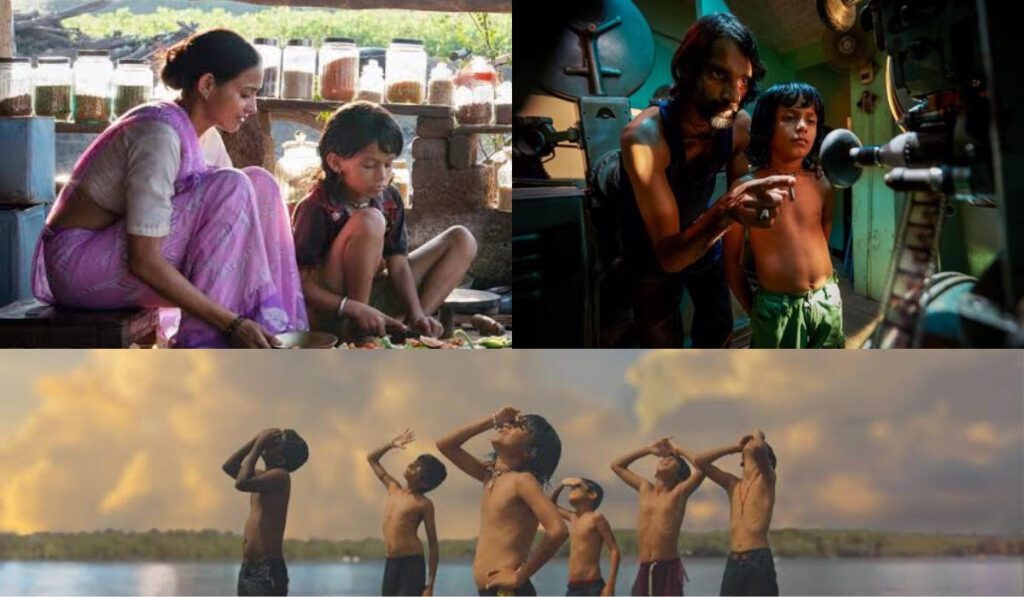Chhellow Show or The Last Film Show : Runs incessantly on your mind and in the theaters.

Chhellow Show or The Last Film Show : Runs incessantly on your mind and in the theaters.
Pan Nalin’s Chhellow Show which came to limelight for its official entry to the Oscars 2023 released commercially in the theaters on October 13th. The film has done an impeccable job in penning down the intrinsic desire of a young lad Samay to make his living as a showrunner for the films and eventually paints a picture of his accentuating inquisitiveness about how films are made. The film runs incessantly on your mind even after you’ve left the theater like the filmic theory of persistence of vision. Set against the backdrop of cinema changing its course with technical advances of digital film penetrating the old celluloid form, the director creates an arc for the protagonist enduring this global transition occurring on the face of filmic history.
Samay, a resident of the Chalala district in Saurashtra passes his time by selling tea from his father’s shop stationed at the Railways and occasionally bunks school to catch matinee shows of whichever film that runs in the theater near him. He is accompanied by a group of friends who always stick by him in his mischievous endeavors and aid him in carrying out all prospects of building a skeleton projector using junk tools available at their disposal. Samay is constantly reprimanded by his father who in the very beginning of the film reflects his Brahminical disregard for the movie business. However, that is no bar for the awestruck Samay who would go any lengths to understand the reasons for his enthusing wonder for cinema. He befriends the projectionist Fazal, at the movie theater by luring him with his mother’s lip-smacking homemade meals for watching the shows for free almost everyday.

The relationship that forms thereon is one that is purely based out the love for cinema from the side of both the characters. Pan Nalin shows us the film through the eyes of innocence and splendor that are completely taken aback by the science behind perceiving the film image, which later on becomes the catalyst to further the cause of Samay’s interest in its making. The director frequently uses primary colours while envisioning the objects of nature, drawing attention to the fact that the image captured in a film primarily consists of the different hues of those particular primary colours. The transition of the film from script to screen is crisp as every shot feels adequately befitting the narrative and evokes a question, or rather a feeling that audiences despite their filmic illiteracy would be able to resonate with. He devices unimaginable ways that could be deployed to project the image from the celluloid and lastly succeeds in running the show for his close ones. The fact that the film had been thoughtfully written is evoked through its picturisation in the very naive scenes where Samay creates a motion picture through still movement, compact framing and gestures and an angle at which the moment is being watched. There are moments in the film which compel one to laud Samay for his effortless strife in getting something done and rejoicing with him as he succeeds.
The shot taking is specific, meaningful and aesthetic in all its senses. Every frame is a beauty in itself and the choreography of it is what makes the film a visual treat. With dominating hues of blue and green, the colour tones roots one to the suburbs of Saurashtra in the late 90s and early 2000. With Samay’s discovery of the power of sound and his strategy of using live audio during the running of the show, his father decides to let his son live his dream after eavesdropping into the “bhoot bangla’ and seeing his whole family engrossed in the amusement
of cinema. As Samay meaning time, had it, the fame of celluloid was only short lived with digital cinema projection taking over the job of many a people, like Fazal. Bhavin Rabari as Samay is lucid in his character and hooks us to the comical quintessential lambasting that he exposes himself to while quenching his thirst for knowledge. Swapnil S. Sonawane has framed the landscape sceneries with the same efficacy as used in having captured the emotional engagements of each of the characters.

Mikael Barre and Gilles Benardeau have minutely carved out the soundscape with the pleasant additions of melody tones by Cyril Morin. Shreyas Beltangdy and Pavan Bat play with the images, but do so carefully and set the pacing in a way that doesn’t let one realise that an hour and fiftty minutes have passed as the credits start rolling. To conclude my analogy, there are a couple of scenes that arouse a sense of appreciation for the film but the one which took my breath away has to be the last scene. The juxtaposition of the visuals with Samay’s increasing knowledge about the starwarts of the cinema realm is splendid not just visually but auditorily and is a narrative wonder when the traditional name taking against the color hues of the celluloid bangles that are seen, passes onto the more mature understanding of the contributors of the cinema movements. What starts out as Samay’s journey would possibly reflect onto aficionados who have breathed cinema since their very exposition to the world of it. Pan Nalin’s semi autobiographical film the Chhellow Show rejuvenates the storyteller in all cinephiles and reminds us the very reason because of which cinema still possesses the potential to marvel us every time we engage in a theatrical experience.
Review by – Subhangi Ray


